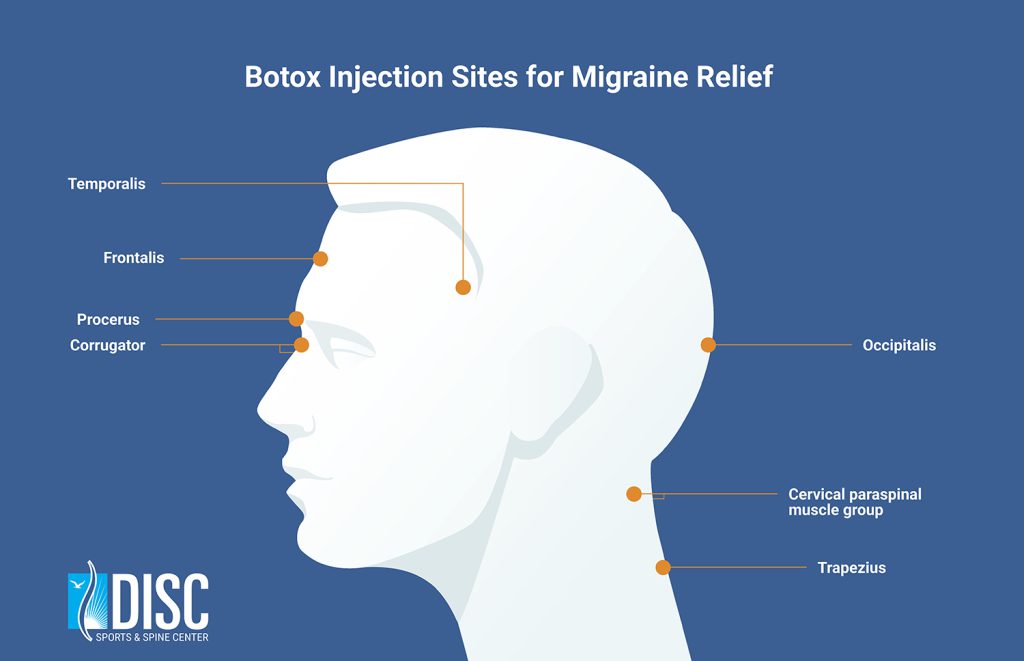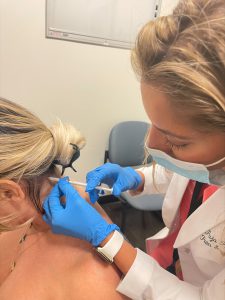
By Dr. Puja Shah, DISC Sports & Spine Center
Over 50 percent of adults between 18-65 years old suffer from headaches at least in some form in their lives. A huge source of morbidity in the human population, headaches present some of the most challenging disorders that we treat as physicians, given their multifactorial etiologies. The types of headaches encompass everything from migraines and tension-type headaches to cluster and sinus headaches, just to name a few.
The reasons people suffer from headaches can vary dramatically from person to person. These variables include physical pathology, such as brain disorders and trauma, hormonal imbalances, chronic stress and other systemic medical issues.
To complicate the story even more, many medications themselves have headaches listed as one of their top side effects. Therefore, it can be very difficult for patients to understand the root causes of their headaches.
When some chronic headaches are downright debilitating – often causing sufferers to lose more than half of every month battling horrific pain – the need to find answers and true relief is all-consuming.
I should know. Although I’m a double-board-certified pain management specialist and anesthesiologist who actively treats chronic headache patients, I am also a patient myself.
I began suffering from migraines at the age of 23, not surprisingly while I was in medical school. The posture that I had developed from studying for hours on end typing and writing led me into a chronic pain cycle of headaches and muscle tension in my neck and shoulder region, and before I knew it, I was desperately seeking help.
I went to many different physicians, including primary care doctors, neurologists, chiropractors and even ayurvedic specialists, never to find a true treatment that worked for me.
Luckily, my holistic background led me to yoga and ever since then, I’ve utilized the benefits of this healing practice to allow myself to de-stress, which has played a huge role in decreasing my own headache days.
And while yoga has been incredibly helpful, I am also one of many migraine patients who has reaped the pain relief benefits of Botox, which has been approved by the FDA for treating chronic migraines and chronic tension-type headaches.

What is Botox and How Does it Work?
Botox is a form of botulinum toxin, a neurotoxin produced by the bacteria that causes botulism. When the Botox botulinum toxin is purified and used in tiny doses in specific areas, it temporarily reduces muscle contractions for approximately three months.
Given that I am a provider who is quite experienced in both holistic wellness and traditional Western medicine, I believe that treating pain from the root cause is the most important. That is why Botox, in my opinion, is one of the best treatment options we have for any pain condition at this time.
The beauty of Botox is that, while it is a toxin, it works in a way that is localized, unlike many medications that lead to a lot of side effects in the body. Botox works at the exact site where the headaches are occurring, targeting the muscles that are related to chronic headaches.
How Botox Stands Up to Oral Medication-Related Options
Although there are many effective pharmaceutical modalities to treat chronic migraines and chronic tension-type headaches (many of which have been researched long-term), they do often come with systemic side effects which can be difficult for patients to tolerate and leave them feeling hopeless about treatment options.
The current treatment options for chronic migraines include prophylactic therapies, which are preventative therapies, as well as abortive therapies, which are treatment therapies that work at the onset of the headache itself.
The side effect profiles of these medications can include low blood pressure, worsening headaches, dizziness, fatigue and changes in weight.
After a patient has failed conservative therapy with these medications, he or she can become a candidate authorized for the use of Botox by their insurance company. Most of my patients have exhausted myriad treatment options by the time they see me, so I feel enthusiastic about explaining to them that their road to treatment – and relief – is not over.
And when the average patient that comes to me for help has over 15 headache days a month – or half of their life dealing with such a difficult symptom – imagine their renewed hope when I tell them this toxin may reduce their headache days by over 50 percent.
In my experience, every single patient that has had Botox treatment for the chronic headaches has done well, and I can count myself among that group.

How Does Botox Treatment for Chronic Headaches Work?
The treatment of Botox for chronic migraines and tension types of headaches is, in some ways, very similar to the use for cosmetic purposes and, in other ways, quite different. In fact, some of the injection sites for headaches include the forehead and inner eye area, which can be the most common areas that clients request Botox for wrinkles.
The classic treatment process involves about 30 injection sites for headaches. These injection sites are located throughout the scalp muscles. The reason being is that migraines and chronic headaches do not just emerge from one location, but rather from chronic sources of muscle tension and inflammation. Therefore, it is important to target all of these muscles in order to lead to long-term relief.
The Botox dosing for chronic headaches is every three months. This is because it’s a medication that does take time to achieve full efficacy. I often tell patients that, after the first treatment, if they are Botox naïve, they may not even notice a difference. After the second and even third treatment, they do notice a significant difference as the cumulative effect of the toxin has relaxed the muscles to a much greater extent.
In my practice, I have not seen a tolerance to the Botox, given that the treatments are extended throughout such a long period of time. This is useful in many ways, as patients don’t have to follow up quicker than three months, and it allows them to have time to really evaluate the effect that it is having for their headaches.
That said, it is important to remember that using Botox for migraines or tension-type headaches is a long-term treatment program. It is all about the marathon and not the sprint. Decreasing muscle tension is the end goal, and reducing headache days from over 15 headache days per month to much less would be the ideal way to see the progress.
Is This a Painful Procedure?
The needle that is used for Botox is a very small micro-needle similar to that of an insulin syringe. It is a quite painless procedure, and it’s done usually within 20 minutes of time. After the procedure, I have the patient lay down and rest for 15 minutes, and I provide them some ice if they do have any swelling in the area.
Usually, in the next 24 to 48 hours, the patient will not notice any significant adverse effects from the treatment. And, as always, it is important to follow up with your physician if you do notice anything outside of the norm.
The Side Effects and Side Benefits of Botox Treatments
As I noted previously, oral medications, although often effective, can cause a slew of side effects in the systemic body whereas Botox treatments target the headache directly. That said, any overmedication is problematic, and overuse of the botulinum toxin can cause prolonged weakness of certain muscles. That is why it’s always important to go to your board-certified physician for evaluation prior to choosing this as a treatment option.
Another side effect – given that many of the injection sites are in the upper-one-third of the face – may be considered more of a side benefit. Not surprisingly, my Botox patients end up having less wrinkles on their foreheads, a pleasant surprise that they enjoy while they experience less headache days.
When I became a physician, I saw the beauty of what Botox is as a toxin for conditions that are not only skin deep. Needless to say, I’ve had great results, not only for my patients, but also for myself. Now I suffer only two to three headache days a month. And with that, I know how best to tackle them. So when your own physician has had a great benefit from this procedure, there really isn’t any better anecdote.
For more information, visit DISC Sports & Spine Center on the web at https://www.discmdgroup.com.




